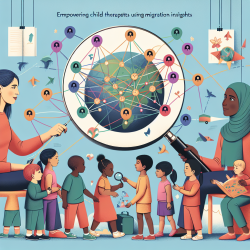Introduction
In the quest to improve child therapy outcomes, understanding broader socio-economic dynamics can offer valuable insights. The research article "The education-chasing labor rush in China identified by a heterogeneous migration-network game" provides a unique perspective on how migration decisions are influenced by educational opportunities. This blog explores how these findings can be applied to enhance speech-language pathology practices, especially in remote or underserved areas.
Understanding Migration Dynamics
The study develops a population game model to analyze Chinese labor migration, revealing that education resources significantly impact migration decisions. Migrants often choose destinations with richer educational opportunities, indicating a strong preference for environments that promise better educational outcomes.
This insight is critical for practitioners working with children, as it underscores the importance of educational resources in shaping developmental trajectories. By understanding these dynamics, therapists can better tailor interventions and advocate for resource allocation that supports educational enrichment.
Applying Research Insights to Therapy Practices
Here are practical ways practitioners can leverage these insights:
- Advocacy for Resources: Use data to advocate for more educational resources in areas where children are underserved. Highlight the link between educational opportunities and migration to push for policy changes.
- Community Engagement: Collaborate with local schools and educational institutions to create programs that enhance educational outcomes, thereby making the area more attractive for families.
- Tailored Interventions: Develop therapy programs that incorporate educational elements, ensuring that children not only receive speech therapy but also benefit from enriched educational experiences.
Encouraging Further Research
The research highlights the need for continued exploration of how socio-economic factors influence child development. Practitioners are encouraged to engage in or support research that examines the intersection of migration, education, and therapy outcomes.
Conclusion
By integrating insights from migration studies, speech-language pathologists can enhance their practice, advocate effectively for resources, and ultimately improve outcomes for children. Understanding the role of education in migration decisions provides a powerful tool for shaping therapy strategies and community engagement.
To read the original research paper, please follow this link: The education-chasing labor rush in China identified by a heterogeneous migration-network game.










